| کد مقاله | کد نشریه | سال انتشار | مقاله انگلیسی | نسخه تمام متن |
|---|---|---|---|---|
| 2817832 | 1160013 | 2012 | 4 صفحه PDF | دانلود رایگان |

Lack of unequivocal markers for assessment of therapeutic effects of treatment procedures is a common problem, but it is especially pronounced in genetic diseases. One of them is Sanfilippo disease (mucopolysaccharidosis type III, or MPS III). Changes in hair morphology have already been reported as one of characteristic and easily detected symptoms of this disease and other mucopolysaccharidoses. This feature has been used previously to monitor efficacy of gene expression-targeted isoflavone therapy (GET IT) in pilot clinical studies performed with low number of patients. Here, we studied changes in hair morphology, observed by using scanning electron microscopy, in 35 patients subjected to GET IT for one year at doses of 5 and 15 mg/kg/day. We have observed statistically significant correction of hair morphology in both groups of patients, corroborating results of earlier studies with low number of patients that suggested easily observable improvement in this parameter during different therapies of MPS. Since the improvement was evident in both previous reports and this study, we propose that analysis of hair morphology may be considered as a non-invasive method in monitoring effects of treatment on somatic symptoms of Sanfilippo disease patients.
► Amount of genistein in genistein-rich soy isoflavone extract equal to either 5 or 15 mg/kg/day.
► Hair morphology was changed after treatment in 26 out of 35 tested MPS III patients.
► Assessment of hair dysmorphology should be considered as a biomarker of tested medicines.
Journal: Gene - Volume 504, Issue 2, 10 August 2012, Pages 292–295